1997 CHEVROLET MONTE CARLO run flat
[x] Cancel search: run flatPage 2 of 358
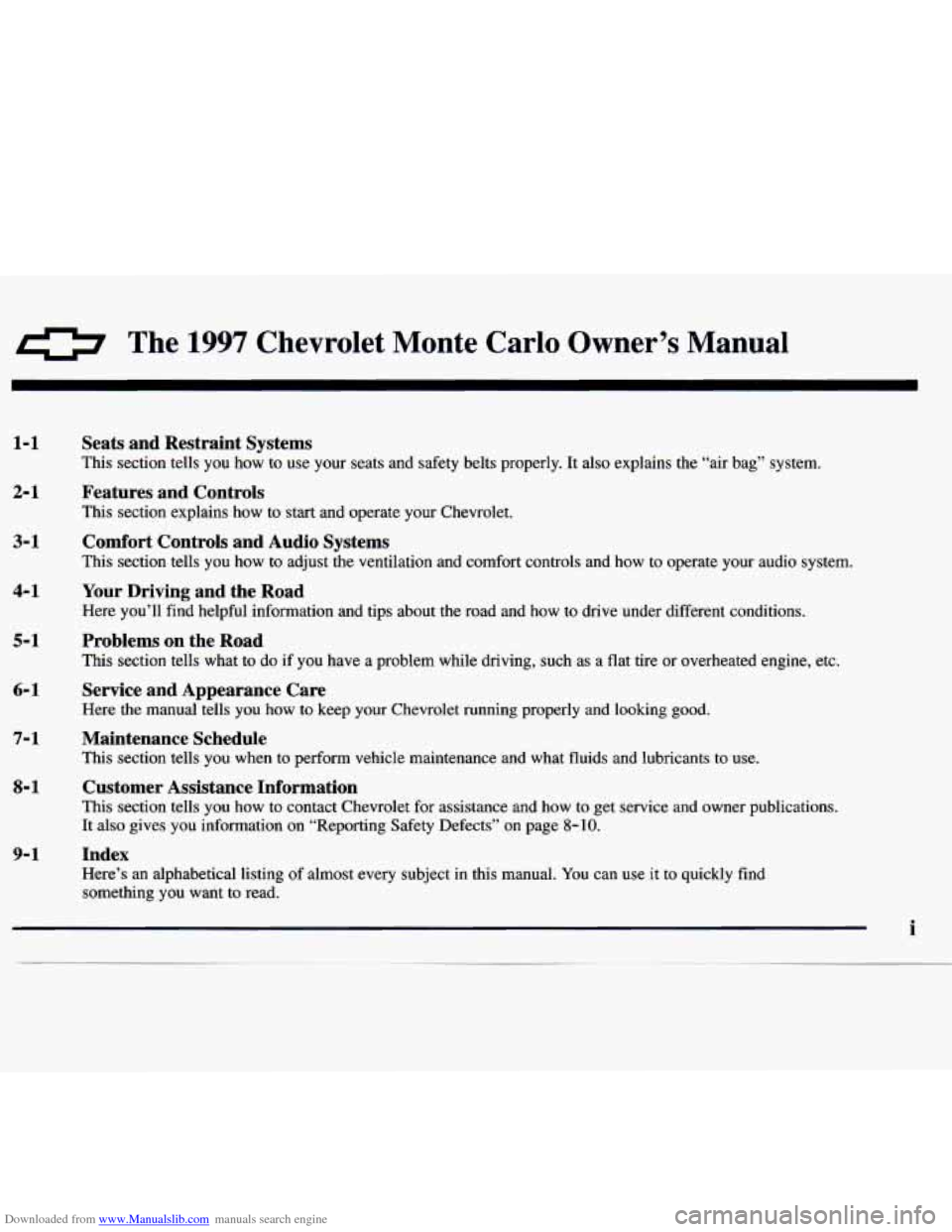
Downloaded from www.Manualslib.com manuals search engine 0 The 1997 Chevrolet Monte Carlo Owner’s Manual
1-1
2-1
3-1
4-1
5-1
6- 1
7-1
8-1
9-1 Seats and Restraint Systems
This section tells you how to use your seats and safety belts properly. It also expl\
ains the “air bag” system.
Features and Controls
This section explains how to start and operate your Chevrolet.
Comfort Controls and Audio Systems
This section tells you how to adjust the ventilation and comfort controls and how to operate your audio \
system.
Your
Driving and the Road
Here you’ll find helpful information and tips about the road\
and how to drive under different conditions.
Problems on the Road
This section tells what to do if you have a problem while driving, such as a flat tire or overheat\
ed engine, etc.
Service and Appearance Care
Here the manual tells you how to keep your Chevrolet running properly and looking good.
Maintenance Schedule
This section tells you when to perform vehicle maintenance and \
what fluids and lubricants to use.
Customer Assistance Information
This section tells you how to contact Chevrolet for assistance \
and how to get service and owner publications.
It also gives
you information on “Reporting Safety Defects” on page 8-10.
Index
Here’s an alphabetical listing of almost every subject in this manual. You can use it to quickly find
something
you want to read.
i
Page 53 of 358
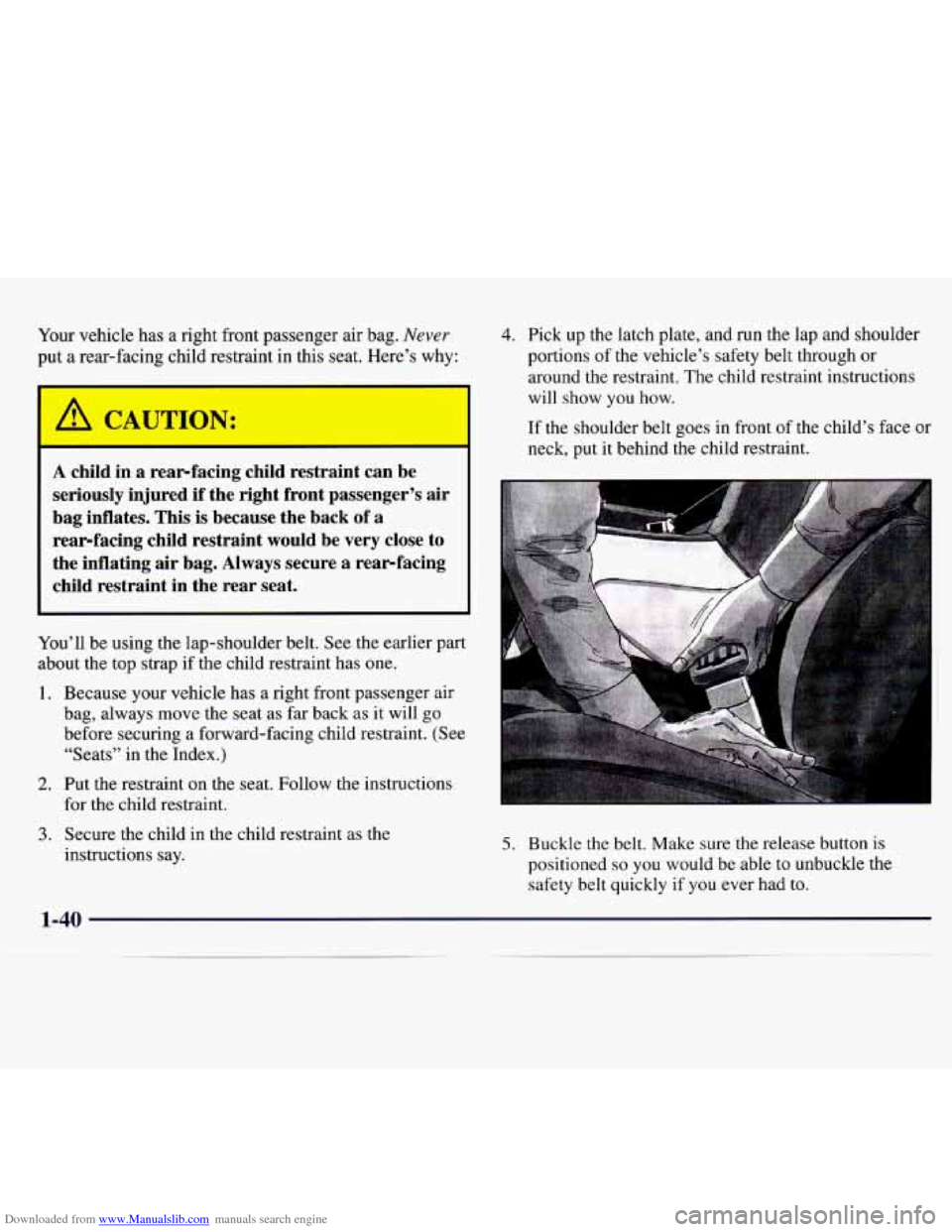
Downloaded from www.Manualslib.com manuals search engine Your vehicle has a right front passenger air bag. Never
put a rear-facing child restraint in this seat. Here’s why:
1 A CAUTION: I
I I
A child in a rear-facing child restraint can be
seriously injured if the right front passenger’s air
bag inflates. This
is because the back of a
rear-facing child restraint would be very close to
the inflating air bag. Always secure a rearfacing
child restraint in the rear seat.
You’ll be using the lap-shoulder belt. See the earlier part
about the top strap if the child restraint has
one.
1. Because your vehicle has a right front passenger air
bag, always move the seat as far back as it will go
before securing a forward-facing child restraint. (See
“Seats”
in the Index.)
2. Put the restraint on the seat. Follow the instructions
for the child restraint.
3. Secure the child in the child restraint as the
instructions say.
4. Pick up the latch plate, and run the lap and shoulder
portions
of the vehicle’s safety belt through or
around the restraint. The child restraint instructions
will show
you how.
If the shoulder belt goes in front
of the child’s face or
neck, put it behind the child restraint.
5. Buckle the belt. Make sure the release button is
positioned
so you would be able to unbuckle the
safety belt quickly if you ever had
to.
1-40
Page 98 of 358

Downloaded from www.Manualslib.com manuals search engine Center Console
To open the storage area, press the button and lift the
cover. The console has a cassette and
CD storage bin
and a cupholder.
To use the cupholder for large cups,
remove the insert.
Convenience Net (Option)
Your vehicle may have a convenience net. You'll see it
just inside the back wall of the trunk.
Put small loads, like grocery bags, behind the net.
It can
help keep them from falling over during sharp turns or
quick starts and stops.
The net
isn't for larger, heavier loads. Store them in the
trunk as far forward as you can.
You can unhook the net
so that it will lie flat when
you're not using
it.
Page 167 of 358
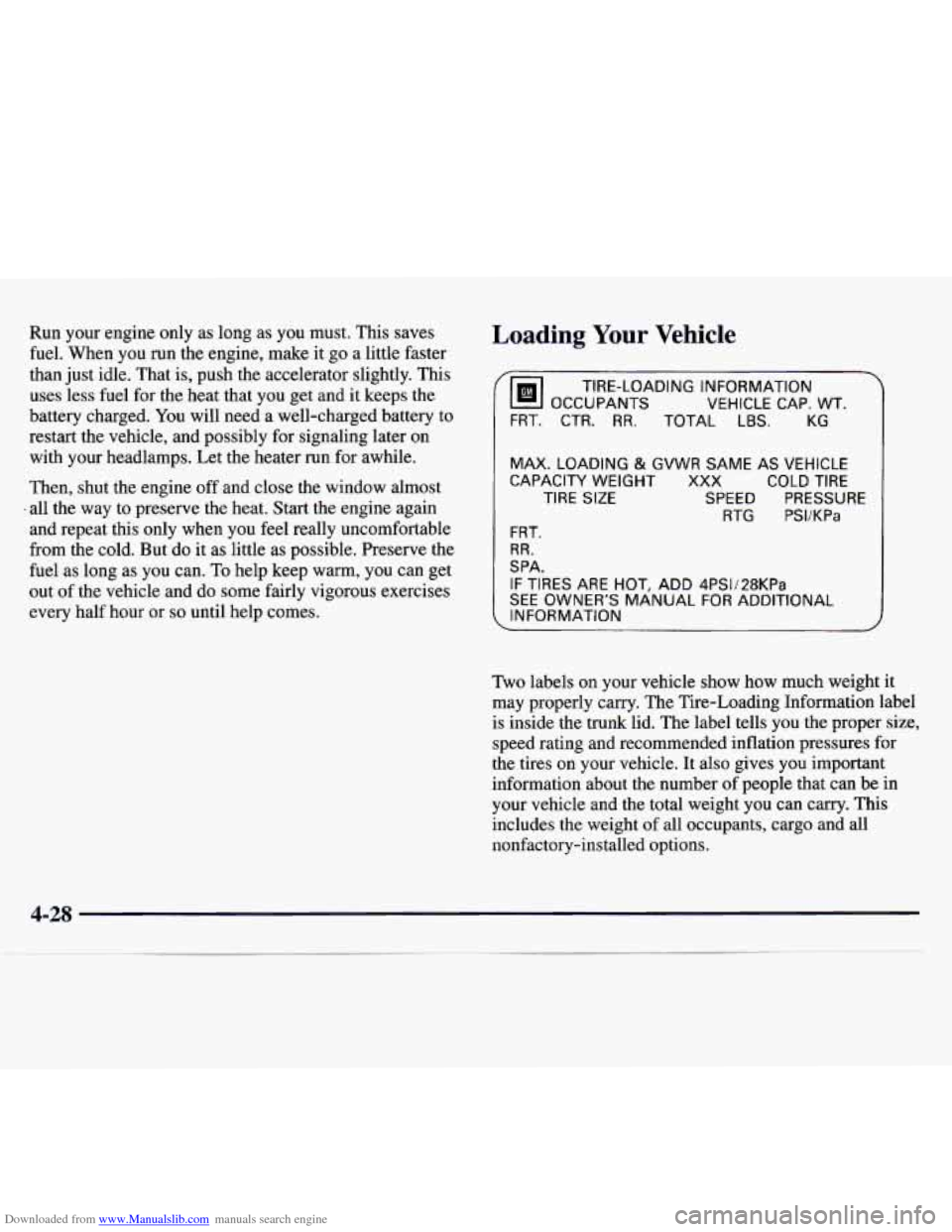
Downloaded from www.Manualslib.com manuals search engine Run your engine only as long as you must. This saves
fuel. When you
run the engine, make it go a little faster
than just idle. That is, push the accelerator slightly. This
uses less fuel for the heat that you get and it keeps the
battery charged. You will need a well-charged battery to
restart the vehicle, and possibly for signaling later
on
with your headlamps. Let the heater run for awhile.
Then, shut the engine off and close the window almost
. all the way to preserve the heat. Start the engine again
and repeat this only when you feel really uncomfortable
from the cold. But do it as little as possible. Preserve the
fuel as long as you can.
To help keep warm, you can get
out
of the vehicle and do some fairly vigorous exercises
every half hour or
so until help comes.
Loading Your Vehicle
ym OCCUPANTS VEHICLE CAP. WT.
TIRE-LOADING INFORMATION
FRT.
CTR. RR. TOTAL LBS. KG
MAX. LOADING & GVWR SAME AS VEHICLE
CAPACITY WEIGHT
XXX COLD TIRE
TIRE SIZE SPEED PRESSURE
RTG PSI/KPa
FRT.
RR.
SPA.
IF TIRES ARE HOT, ADD 4PS1/28KPa
SEE OWNER’S MANUAL FOR ADDITIONAL
INFORMATION
Two labels on your vehicle show how much weight it
may properly carry. The Tire-Loading Information label
is inside the
trunk lid. The label tells you the proper size,
speed rating and recommended inflation pressures for
the tires on your vehicle.
It also gives you important
information about
the number of people that can be in
your vehicle and
the total weight you can carry. This
includes the weight of all occupants, cargo and all
nonfactory-installed options.
4-28
Page 172 of 358

Downloaded from www.Manualslib.com manuals search engine A B
If you’re using a weight-carrying hitch, the trailer
tongue
(A) should weigh 10 percent of the total loaded
trailer weight (B). If you have
a weight-distributing
hitch, the trailer tongue
(A) should weigh 12 percent of
the total loaded trailer weight
(B).
After you’ve loaded your trailer, weigh the trailer and
then the tongue, separately, to see if the weights are
proper. If they aren’t, you may be able to get them right
simply by moving some items around in the trailer.
Total Weight on Your Vehicle’s Tires
Be sure your vehicle’s tires are inflated to the upper
limit for cold tires. You’ll find these numbers on the
Tire-Loading Information label (found inside the trunk
lid) or see “Loading Your Vehicle” in the Index. Then be
sure you don’t go over the GVW limit for your vehicle,
including the weight
of the trailer tongue.
Hitches
It’s important to have the correct hitch equipment.
Crosswinds, large trucks going by and rough roads are a
few reasons why you’ll need the right hitch. Here are
some rules to follow:
The bumpers on your vehicle are not intended for
hitches.
Do not attach rental hitches or other
bumper-type hitches to them. Use only a
frame-mounted hitch that does not attach to
the bumper.
Will you have to make any holes in the body of your
vehicle when you install a trailer hitch? If you do,
then be sure to seal the holes later when you remove
the hitch. If you don’t seal them, deadly carbon
monoxide (CO) from your exhaust can get into your
vehicle (see “Carbon Monoxide” in the Index). Dirt
and water can, too.
Page 209 of 358
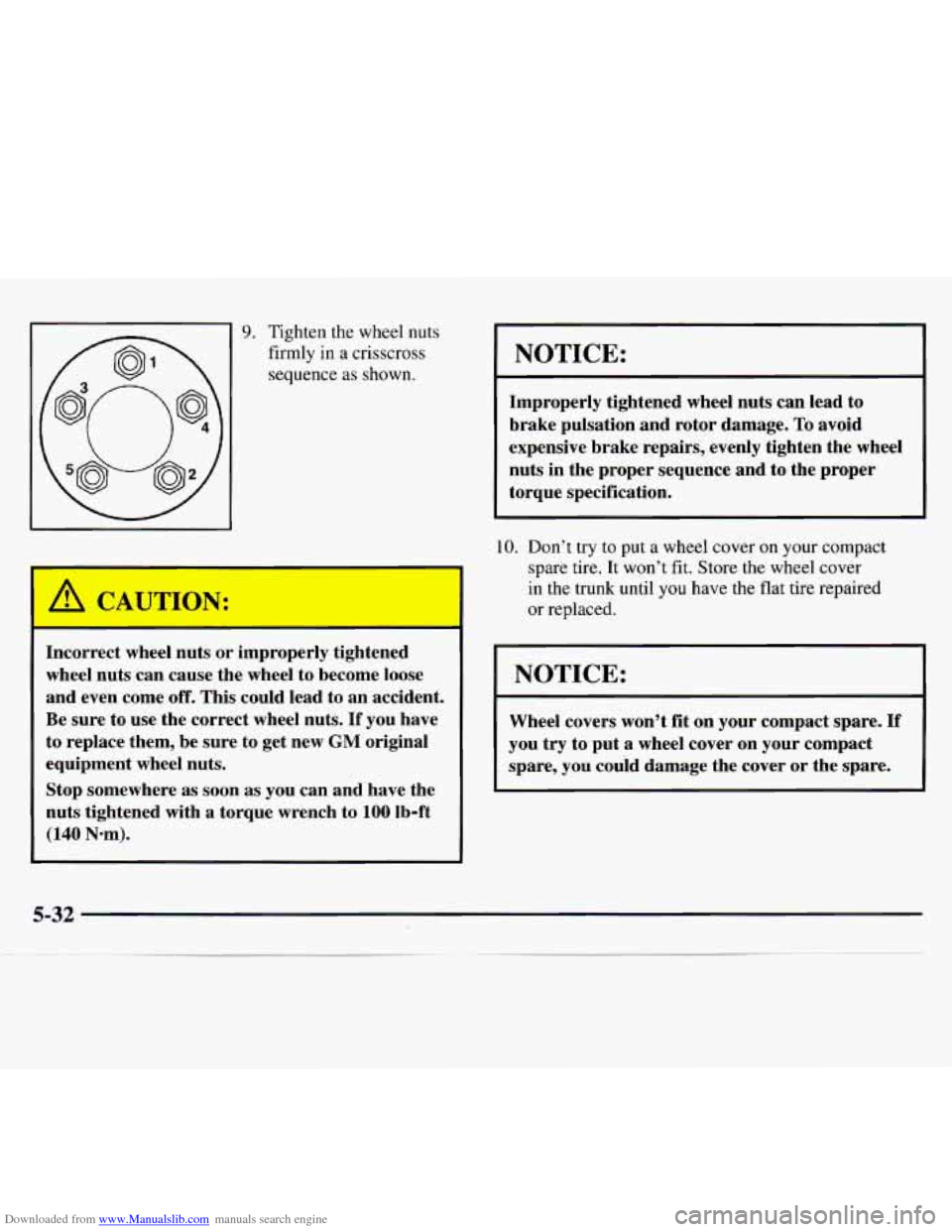
Downloaded from www.Manualslib.com manuals search engine 9. Tighten the wheel nuts
firmly in a crisscross
sequence as shown.
r
Incorrect wheel nuts or improperly tightened
wheel nuts can cause the wheel to become loose
and even come
off. This could lead to an accident.
Be sure to use the correct wheel nuts.
If you have
to replace them, be sure to get new
GM original
equipment wheel nuts.
Stop somewhere as soon
as you can and have the
nuts tightened
with a torque wrench to 100 Ib-ft
(140 Nom).
~ NOTICE:
Improperly tightened wheel nuts can lead to
brake pulsation and rotor damage.
To avoid
expensive brake repairs, evenly tighten the wheel
nuts in the proper sequence and to the proper
torque specification.
10. Don’t try to put a wheel cover on your compact
spare tire.
It won’t fit. Store the wheel cover
in the trunk until you have the flat tire repaired
or replaced.
I NOTICE:
Wheel covers won’t fit on your compact spare. If
you try to put a wheel cover on your compact
spare, you could damage the cover or the spare.
1
5-32
Page 210 of 358

Downloaded from www.Manualslib.com manuals search engine Storing the Flat Tire and Tools
1
I A CAUTION: I
Storing a jack, a tire or other equipment in the
passenger compartment
of the vehicle could
cause injury. In a sudden stop or collision, loose
equipment could strike someone. Store all these
in the proper place.
After you’ve put the compact spare tire on your vehicle
you’ll need to store the flat tire in your trunk. Use the
following procedure to secure the flat tire in the trunk.
Put the flat tire in the trunk
so the side that faces out
when it is on the vehicle is facing down. The full-size
tire will
not fit down into the well. Place it so the front is
in the well and the rear
is out of the well. Put the bolt through
one of the wheel nut holes, install
the retainer over the bolt, then install the wing
nut. Put
the spacer and
nut next to the tire in the well. Store the
cover
as far forward as possible.
The compact spare is for temporary use only. Replace
the compact spare tire with a full-size tire as
soon as you
can. See “Compact Spare”
in the Index. See the storage
instructions label to replace your compact spare into
your trunk properly.
When you install the wheel cover on the full size tire,
tighten the nut caps
to 5 lb-ft (7 N-m).
Page 251 of 358
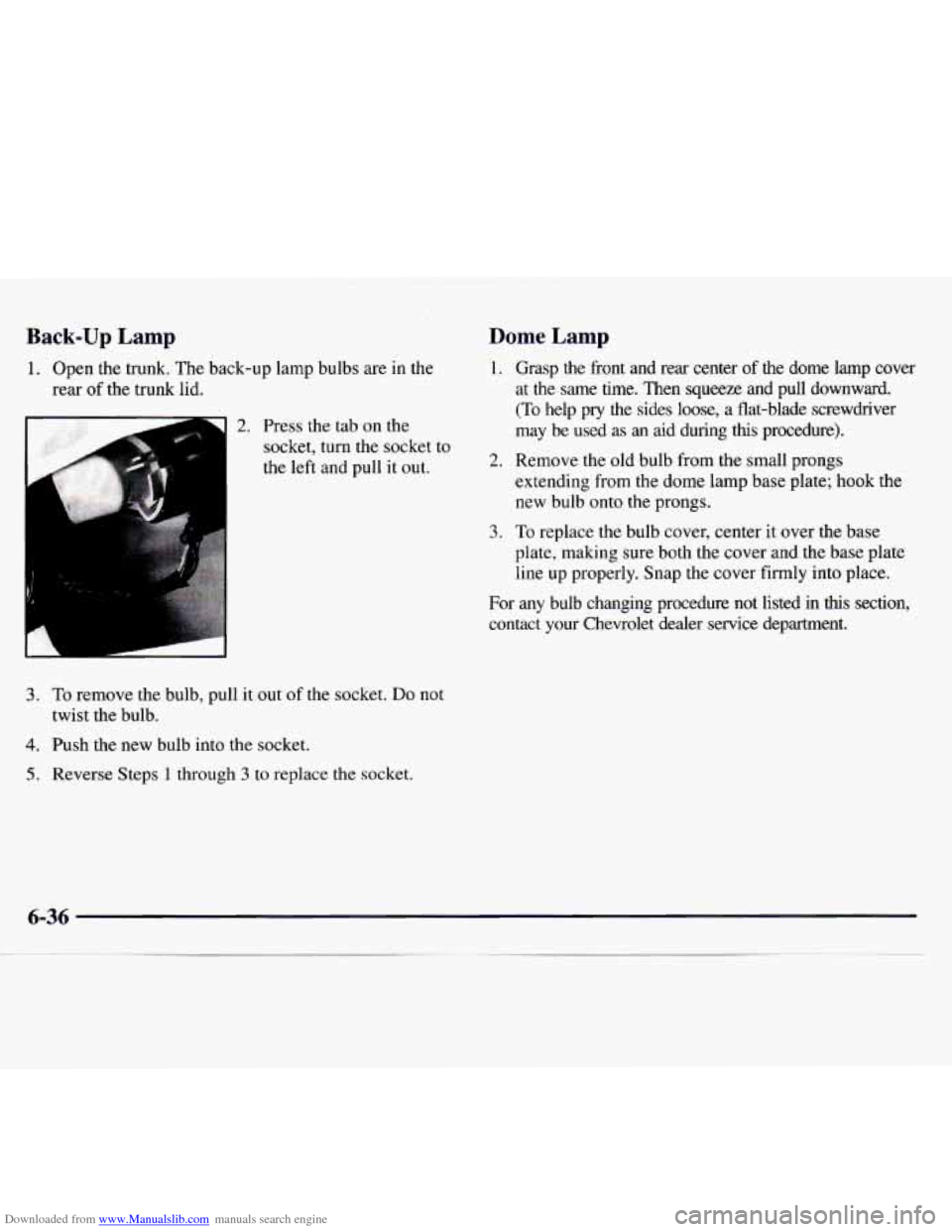
Downloaded from www.Manualslib.com manuals search engine Back-up Lamp
1. Open the trunk. The back-up lamp bulbs are in the
rear of the trunk lid.
2. Press the tab on the
socket, turn the socket to
the left and pull it out.
3. To remove the bulb, pull it out of the socket. Do not
4. Push the new bulb into the socket.
twist the
bulb.
5. Reverse Steps 1 through 3 to replace the socket.
Dome Lamp
1. Grasp the front and rear center of the dome lamp cover
at the same time. Then squeeze and pull downward.
(To help pry the sides loose, a flat-blade screwdriver
may be used as
an aid during hs procedure).
I. Remove the old bulb from the small prongs
extending
from the dome lamp base plate; hook the
new bulb onto the prongs.
3. To replace the bulb cover, center it over the base
plate, making sure both the cover and the base plate
line up properly. Snap the cover firmly into place.
For any bulb changing procedure not listed in
this section,
contact your Chevrolet dealer service department.